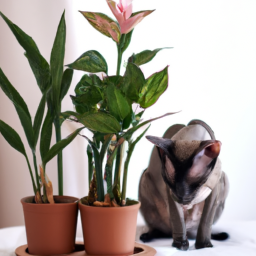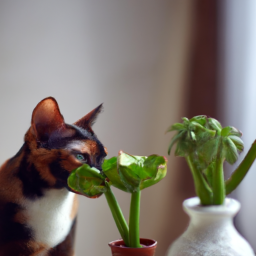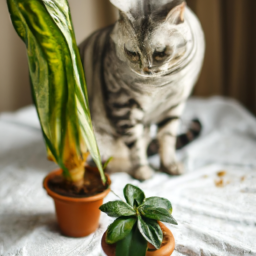
Have you ever wondered what indoor plants are poisonous to cats? As a cat owner, it’s important to be aware of the potential dangers that certain houseplants can pose to your feline friend. While plants can liven up your home and improve air quality, some common varieties can be toxic to cats if ingested. In this blog post, we’ll explore some of the most common indoor plants that are harmful to cats and how you can keep your furry companion safe.
Common Indoor Plants That Are Toxic to Cats
Why are some indoor plants toxic to cats?
When it comes to indoor plants that are toxic to cats, it all comes down to the chemicals and compounds that are present in the plant. Many common indoor plants contain substances that can be harmful or even deadly to cats if ingested. These substances can range from mildly irritating to extremely toxic, depending on the plant and the amount ingested.
One of the main reasons why some indoor plants are toxic to cats is because they contain compounds such as alkaloids, glycosides, and saponins, which can be harmful to cats when ingested. These compounds can cause a range of symptoms in cats, including vomiting, diarrhea, lethargy, and even organ failure in severe cases.
It’s important to be aware of the indoor plants that are toxic to cats so that you can keep your feline friend safe and healthy. By knowing which plants to avoid or keep out of reach of your cat, you can help prevent accidental poisoning and keep your cat out of harm’s way.
Common indoor plants that are toxic to cats
There are several common indoor plants that are toxic to cats, including:
– Lilies: Lilies are highly toxic to cats and can cause kidney failure if ingested. Even a small amount of lily pollen or leaves can be deadly to cats, so it’s best to keep lilies out of your home if you have a cat.
– Pothos: Pothos plants contain calcium oxalate crystals, which can cause irritation and swelling in the mouth and throat if ingested by cats. Symptoms of pothos poisoning in cats include drooling, vomiting, and difficulty swallowing.
– Dieffenbachia: Dieffenbachia plants contain calcium oxalate crystals as well, which can cause similar symptoms as pothos poisoning in cats. Ingesting dieffenbachia can lead to oral irritation, drooling, and difficulty breathing in cats.
– Philodendron: Philodendron plants also contain calcium oxalate crystals and can cause similar symptoms in cats as pothos and dieffenbachia poisoning. It’s best to keep philodendron plants out of reach of your cat to prevent accidental ingestion.
– Snake plant: Snake plants are toxic to cats and can cause symptoms such as vomiting, diarrhea, and lethargy if ingested. It’s best to keep snake plants out of your home if you have a cat to prevent poisoning.
By being aware of the indoor plants that are toxic to cats and taking steps to keep them out of reach of your feline friend, you can help ensure that your cat stays safe and healthy. If you suspect that your cat has ingested a toxic plant, it’s important to contact your veterinarian immediately for advice and treatment.

How to Identify and Remove Poisonous Plants from Your Home
Understanding the Risks of Poisonous Plants for Cats
When it comes to keeping your furry feline friends safe, it’s important to be aware of the potential dangers that certain indoor plants can pose. Cats are known for their curious nature and love of exploring their surroundings, which can sometimes lead them to nibble on plants that may be harmful to their health. Some common symptoms of plant poisoning in cats include vomiting, diarrhea, lethargy, and even more severe reactions such as difficulty breathing or seizures.
To ensure the safety of your beloved pet, it’s crucial to familiarize yourself with the types of indoor plants that are toxic to cats. Some common examples include lilies, aloe vera, philodendron, and pothos. These plants contain substances that can be harmful if ingested by cats, so it’s best to keep them out of reach or remove them from your home altogether.
If you suspect that your cat has ingested a poisonous plant, it’s important to seek immediate veterinary care. Your vet may recommend inducing vomiting or administering activated charcoal to help prevent further absorption of toxins. In severe cases, your cat may require more intensive treatment such as intravenous fluids or medication to counteract the effects of the poisoning.
Identifying Poisonous Plants in Your Home
One of the first steps in protecting your cat from toxic plants is to be able to identify them in your home. Look out for plants with leaves that have a glossy or waxy appearance, as these may contain toxic substances. Additionally, plants with thorns or spines should be kept out of reach of your cat, as they can cause injury as well as poisoning.
Some common indoor plants that are toxic to cats include:
– Lilies: These beautiful flowers are highly toxic to cats, especially if ingested. Even a small amount of lily pollen or leaves can cause severe kidney damage in cats.
– Aloe Vera: While aloe vera is known for its medicinal properties for humans, it can be toxic to cats if ingested. Symptoms of aloe vera poisoning in cats include vomiting, diarrhea, and tremors.
– Philodendron: This popular houseplant contains calcium oxalate crystals, which can cause irritation and swelling in the mouth and throat if ingested by cats.
– Pothos: Another common houseplant, pothos contains insoluble calcium oxalate crystals that can cause oral irritation and difficulty swallowing in cats.
To prevent accidental ingestion of toxic plants, consider keeping them in a separate room or using hanging planters to keep them out of reach of your cat. You can also create a designated safe space for your cat with non-toxic plants such as spider plants, catnip, or cat grass.
Removing Poisonous Plants from Your Home
If you have identified toxic plants in your home, it’s important to take action to remove them and replace them with cat-safe alternatives. Start by carefully removing the toxic plants from their pots and disposing of them in a secure garbage bag. Be sure to wear gloves to protect yourself from any potential toxins on the plants.
Once you have removed the toxic plants, consider replacing them with cat-friendly alternatives such as spider plants, catnip, or cat grass. These plants are safe for cats to nibble on and can provide enrichment for your furry friend.
In conclusion, being aware of the potential dangers of toxic plants for cats is essential for keeping your pet safe and healthy. By familiarizing yourself with common poisonous plants, identifying them in your home, and taking steps to remove them, you can create a safe environment for your feline friend to thrive. Remember, when in doubt, always consult with your veterinarian for guidance on plant safety for your cat.

Tips for Creating a Cat-Safe Indoor Garden
Creating a cat-safe indoor garden is essential for the health and well-being of your feline friend. Cats are curious creatures, and they love to explore their surroundings, including plants. However, some indoor plants can be toxic to cats if ingested. To ensure that your indoor garden is safe for your furry companion, follow these tips:
Choose Non-Toxic Plants
When selecting plants for your indoor garden, it’s important to choose varieties that are non-toxic to cats. Some common houseplants that are safe for cats include spider plants, Boston ferns, and African violets. These plants are not only safe for your feline friend, but they also add beauty and greenery to your home. Avoid plants such as lilies, aloe vera, and pothos, as these are toxic to cats and can cause symptoms such as vomiting, diarrhea, and lethargy if ingested.
It’s also a good idea to research specific plants before bringing them into your home to ensure that they are safe for your cat. Look for plants that are labeled as pet-friendly or non-toxic to cats to avoid any potential health risks.
In addition to choosing non-toxic plants, consider placing them in elevated or hanging planters to prevent your cat from accessing them. Cats are known for their climbing and jumping abilities, so it’s important to keep plants out of reach to avoid any accidental ingestion.
Regularly inspect your plants for signs of damage or wilting, as some cats may be attracted to plants that are in distress. Remove any damaged leaves or flowers to prevent your cat from nibbling on them and potentially ingesting toxic substances.
Provide Alternative Greenery
To satisfy your cat’s natural instinct to chew on plants, consider providing them with alternative greenery such as cat grass or catnip. These plants are safe for cats to chew on and can help satisfy their cravings for greenery without posing any health risks.
Cat grass, in particular, is a popular choice for indoor cats as it provides essential nutrients and aids in digestion. You can easily grow cat grass at home in a small planter and offer it to your cat as a healthy snack. Catnip is another favorite among felines and can be grown indoors in a pot or planter for your cat to enjoy.
By providing your cat with alternative greenery, you can help prevent them from chewing on toxic plants in your indoor garden. Be sure to monitor your cat’s consumption of cat grass or catnip to ensure they are not overindulging, as excessive ingestion can lead to digestive issues.
Monitor Your Cat’s Behavior
Even with a cat-safe indoor garden, it’s important to monitor your cat’s behavior around plants to ensure their safety. Some cats may be more curious or mischievous than others and may still attempt to nibble on plants despite your best efforts to deter them.
If you notice your cat showing interest in a particular plant, consider placing it in a separate room or using deterrents such as bitter apple spray to discourage them from chewing on it. You can also provide your cat with plenty of toys and scratching posts to keep them entertained and engaged, reducing their desire to explore plants.
Regularly observe your cat for any signs of illness or distress, such as vomiting, diarrhea, or lethargy, which may indicate that they have ingested a toxic plant. If you suspect that your cat has consumed a toxic plant, contact your veterinarian immediately for guidance on how to proceed.
By following these tips for creating a cat-safe indoor garden, you can provide a safe and enriching environment for your feline companion to enjoy. With the right plants, precautions, and monitoring, you can create a beautiful indoor garden that is both safe and enjoyable for your cat.
Let’s recap
If you’re a cat owner who loves to fill your home with lush greenery, it’s important to be aware of which indoor plants could be harmful to your feline friend. Some common houseplants can be toxic to cats if ingested, causing symptoms ranging from mild irritation to more serious health issues.
Plants such as lilies, philodendron, and aloe vera are known to be poisonous to cats. Even plants like ivy, peace lilies, and jade plants can cause gastrointestinal upset or skin irritation if your cat comes into contact with them. To keep your furry friend safe, it’s best to research which plants are safe for cats and avoid bringing any potentially harmful ones into your home. Consider opting for cat-friendly plants like spider plants, Boston ferns, or African violets instead to create a safe and beautiful indoor garden for you and your pet to enjoy.
FAQ Roundup:
Q1: Are there indoor plants that are poisonous to cats?
A1: Yes, there are several common indoor plants that are toxic to cats if ingested.
Q2: What are some indoor plants that are poisonous to cats?
A2: Some examples of indoor plants that are toxic to cats include lilies, philodendron, pothos, and peace lilies.
Q3: How can I keep my cat safe from poisonous indoor plants?
A3: To keep your cat safe, consider keeping toxic plants out of your home or placing them in areas that are inaccessible to your cat.
Q4: What are the symptoms of plant poisoning in cats?
A4: Symptoms of plant poisoning in cats can vary but may include vomiting, diarrhea, lethargy, drooling, and difficulty breathing.
Q5: What should I do if I suspect my cat has ingested a poisonous plant?
A5: If you suspect your cat has ingested a toxic plant, contact your veterinarian immediately or call a pet poison helpline for guidance on how to proceed.
Dr. Olivia Green is a botanist with over two decades of experience in indoor plant cultivation. She holds a Ph.D. in Plant Biology and has dedicated her career to researching plant behavior in controlled environments. Dr. Green is passionate about helping plant enthusiasts master the art of indoor gardening through her extensive knowledge and practical insights.


